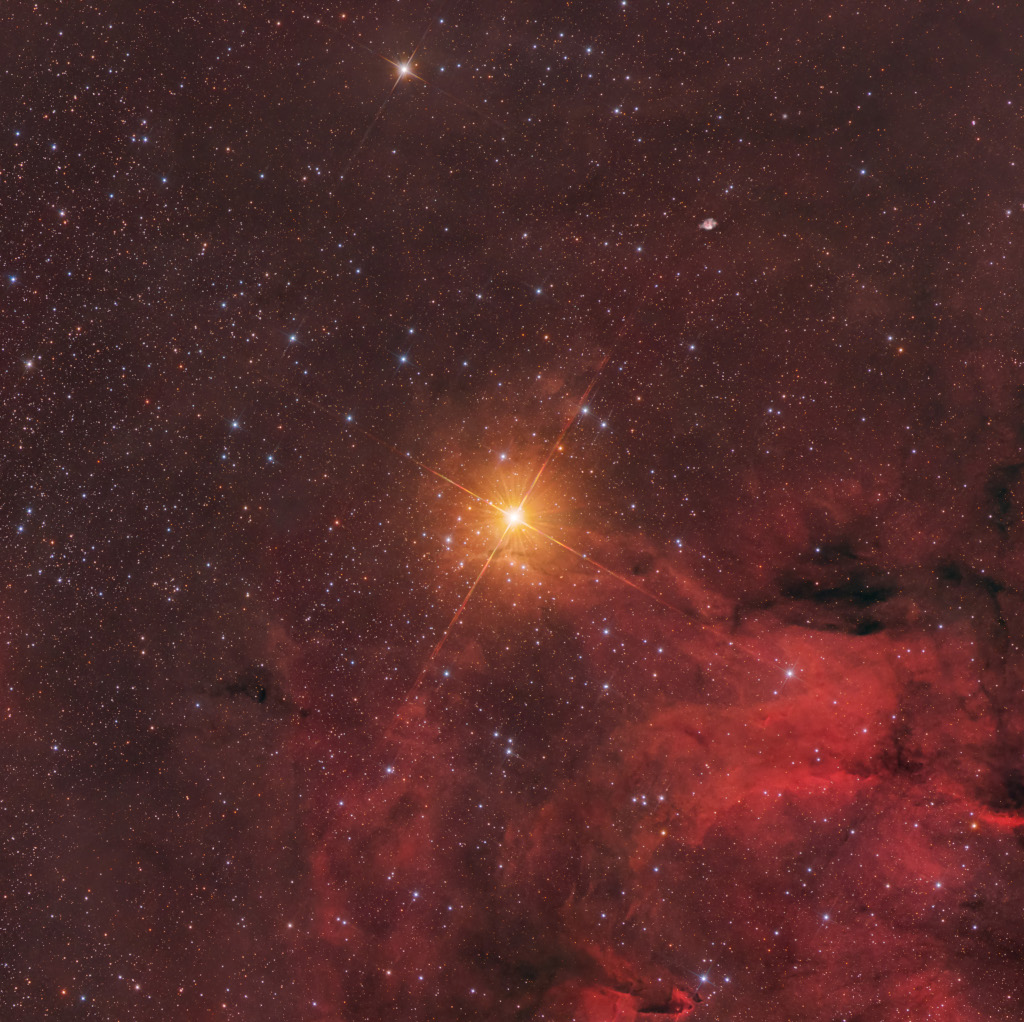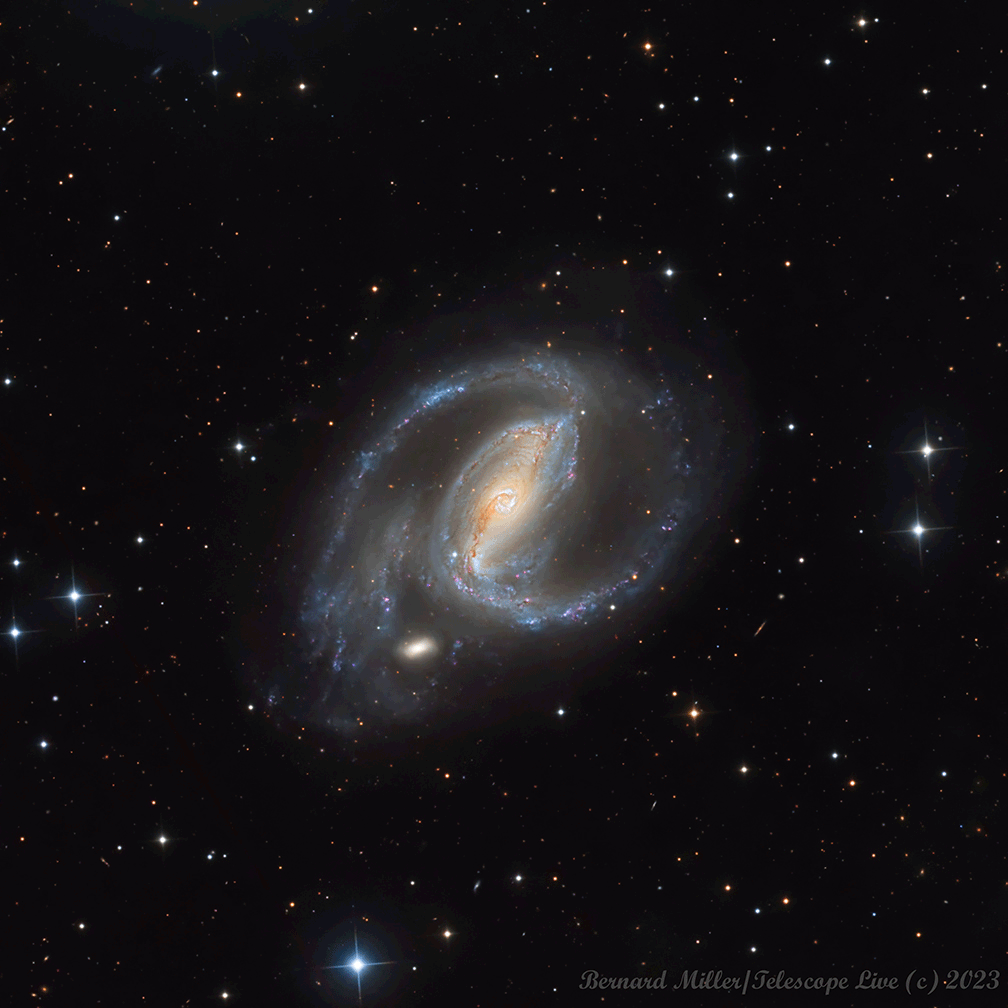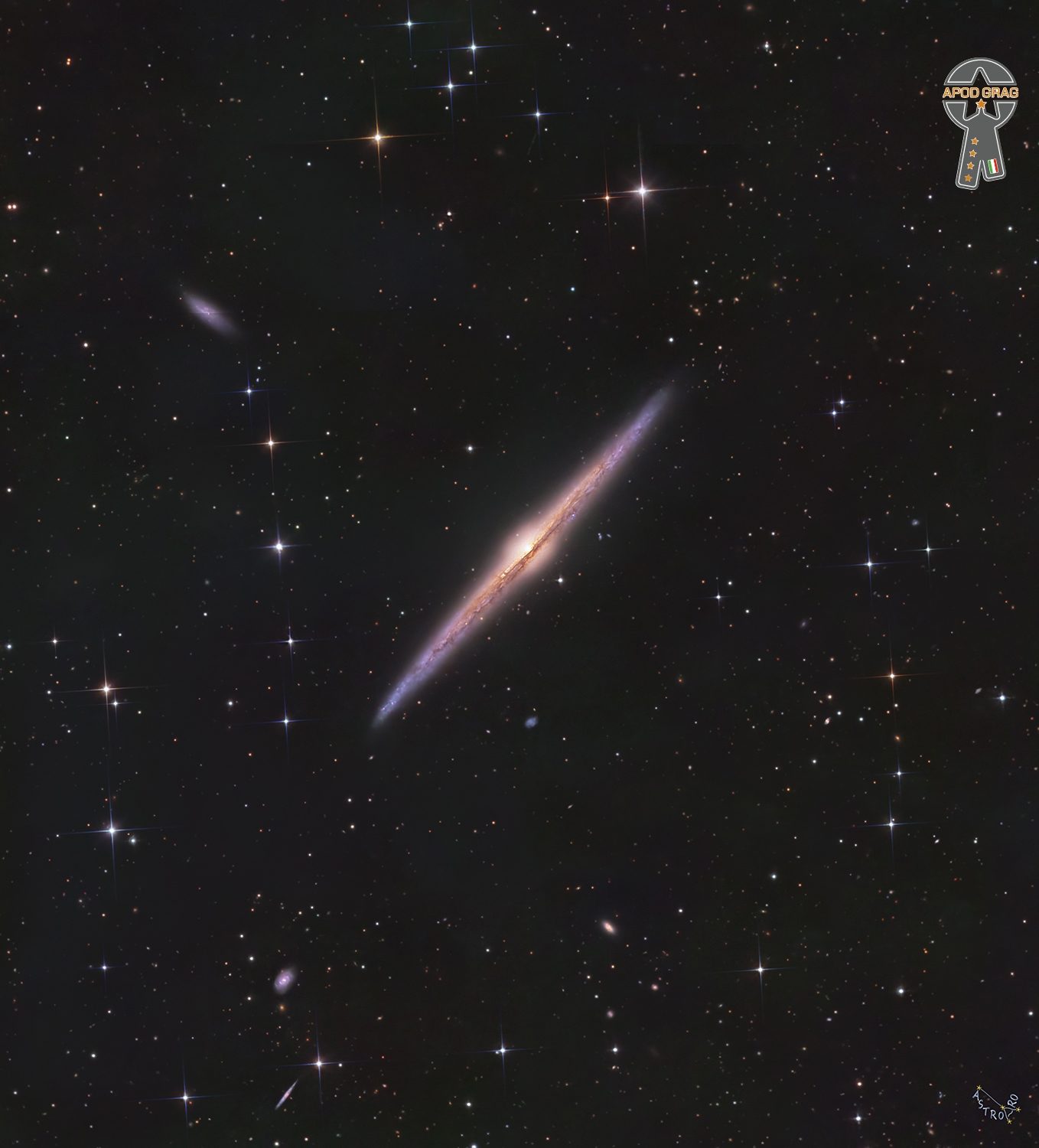Blog
Gorgeous spiral galaxy Messier 33 seems to have more than its fair share of glowing hydrogen gas. A prominent member of the local group of galaxies, M33 is also known as the Triangulum Galaxy and lies a mere 3 million light-years away. The galaxy’s central 30,000 light-years or so are shown in this sharp galaxy portrait. The portrait features M33’s reddish ionized hydrogen clouds or HII regions. Sprawling along loose spiral arms that wind toward the core, M33’s giant HII regions are some of the largest known stellar nurseries, sites of the formation of short-lived but very massive stars. Intense ultraviolet radiation from the luminous, massive stars ionizes the surrounding hydrogen gas and ultimately produces the characteristic red glow. In this image, broadband data were combined with narrowband data recorded through a hydrogen-alpha filter. That filter transmits the light of the strongest visible hydrogen emission line.

more...
Paul Frederic Simon (born October 13, 1941) is an American singer-songwriter. One of the most celebrated artists of the twentieth century, Simon’s career spans six decades. Born in New Jersey, Simon grew up in Queens, New York City, and developed an interest in rock music in his teens.
He began performing with his schoolfriend Art Garfunkel in 1956. They came to prominence in the 1960s as Simon & Garfunkel. Their blend of folk and rock, in hits such as “The Sound of Silence“, “Mrs. Robinson“, “America” and “The Boxer“, served as a soundtrack to the counterculture movement. Their final album before disbanding, Bridge Over Troubled Water (1970), is among the bestselling of all time. In his solo career, Simon has explored genres including gospel, reggae and soul. His celebrated 1970s output—comprising Paul Simon (1972), There Goes Rhymin’ Simon (1973), and Still Crazy After All These Years (1975)—kept him in the public spotlight and drew acclaim, producing the hits “Mother and Child Reunion“, “Me and Julio Down by the Schoolyard“, and “50 Ways to Leave Your Lover“. Simon has reunited with Garfunkel for several tours, including the 1981 Concert in Central Park.
Graceland (1986) is Simon’s most successful and acclaimed album, incorporating worldbeat styles. Its single “You Can Call Me Al” became one of Simon’s most successful. It was followed by The Rhythm of the Saints(1990), and a second Concert in the Park, without Garfunkel, in 1991, attended by half a million people. Simon wrote a Broadway musical, The Capeman (1998), which was poorly received. In the 21st century, Simon continued to record and tour. His later albums, such as You’re the One (2000), So Beautiful or So What (2011), and Stranger to Stranger (2016), have introduced him to new generations. Though he retired from touring in 2018, Simon continues to record music and his album Seven Psalms was released in May 2023.
Simon is among the most acclaimed musicians in popular music, and one of the world’s best-selling music artists, both for his solo work and with Garfunkel. He is a two-time inductee into the Rock and Roll Hall of Fame, and has been the recipient of sixteen Grammy Awards, including three for Album of the Year. Two of his works, Sounds of Silence and Graceland, have seen induction into National Recording Registry for their cultural significance, and in 2007, the Library of Congress crowned him the inaugural winner of the Gershwin Prize for Popular Song. He is a co-founder of the Children’s Health Fund, a nonprofit organization that provides medical care to children.
more...
Pharoah Sanders (born Ferrell Lee Sanders; October 13, 1940 – September 24, 2022) was an American jazz saxophonist. Known for his overblowing, harmonic, and multiphonic techniques on the saxophone, as well as his use of “sheets of sound“, Sanders played a prominent role in the development of free jazz and spiritual jazz through his work as a member of John Coltrane‘s groups in the mid-1960s, and later through his solo work. He released over thirty albums as a leader and collaborated extensively with vocalist Leon Thomas and pianist Alice Coltrane, among many others. Fellow saxophonist Ornette Coleman once described him as “probably the best tenor player in the world”.
Sanders’ take on “spiritual jazz” was rooted in his inspiration from religious concepts such as Karma and Tawhid, and his rich, meditative performance aesthetic. This style was seen as a continuation of Coltrane’s work on albums such as A Love Supreme. As a result, Sanders was considered to have been a disciple of Coltrane or, as Albert Ayler said, “Trane was the Father, Pharoah was the Son, I am the Holy Ghost”. Pharoah Sanders was born on October 13, 1940, in Little Rock, Arkansas. His mother worked as a cook in a school cafeteria, and his father worked for the City of Little Rock. An only child, Sanders began his musical career accompanying church hymns on clarinet.
more...Raymond Matthews Brown (October 13, 1926 – July 2, 2002) was an American jazz double bassist, known for his extensive work with Oscar Peterson and Ella Fitzgerald. He was also a founding member of the group that would later develop into the Modern Jazz Quartet.
Ray Brown was born on October 13, 1926, in Pittsburgh, Pennsylvania, and took piano lessons as a child. After noticing how many pianists attended his high school, he thought of taking up the trombone, but his father was unable to afford one. With a vacancy in the high school jazz orchestra, he took up the upright bass instead.
more...Arthur Tatum Jr. (/ˈteɪtəm/, October 13, 1909 – November 5, 1956) was an American jazz pianist who is widely regarded as one of the greatest ever.[1][2] From early in his career, fellow musicians acclaimed Tatum’s technical ability as extraordinary. Tatum also extended jazz piano’s vocabulary and boundaries far beyond his initial stride influences, and established new ground through innovative use of reharmonization, voicing, and bitonality.
Tatum grew up in Toledo, Ohio, where he began playing piano professionally and had his own radio program, rebroadcast nationwide, while still in his teens. He left Toledo in 1932 and had residencies as a solo pianist at clubs in major urban centers including New York, Chicago, and Los Angeles. In that decade, he settled into a pattern he followed for most of his career – paid performances followed by long after-hours playing, all accompanied by prodigious consumption of alcohol. He was said to be more spontaneous and creative in such venues, and although the drinking did not hinder his playing, it did damage his health.
In the 1940s, Tatum led a commercially successful trio for a short time and began playing in more formal jazz concert settings, including at Norman Granz-produced Jazz at the Philharmonic events. His popularity diminished towards the end of the decade, as he continued to play in his own style, ignoring the rise of bebop. Granz recorded Tatum extensively in solo and small group formats in the mid-1950s, with the last session only two months before Tatum’s death from uremia at the age of 47.
more...The flamenco Farruca, thought to originate in Galicia, Spain, was traditionally danced by men with no singing component. Travelers to the Andalusian region were called farrucos, so this is likely where the Farruca palo name came from. The Farruca is usually played in A minor, with a compás of two measures of 4/4 time signature with accents on beats 1, 3, 5, and 7.
more...Mu Cephei is a very large star. An M-class supergiant some 1500 times the size of the Sun, it is one of the largest stars visible to the unaided eye, and even one of the largest in the entire Galaxy. If it replaced the Sun in our fair Solar System, Mu Cephei would easily engulf Mars and Jupiter. Historically known as Herschel’s Garnet Star, Mu Cephei is extremely red. Approximately 2800 light-years distant, the supergiant is seen near the edge of reddish emission nebula IC 1396 toward the royal northern constellation Cepheus in this telescopic view. Much cooler and hence redder than the Sun, this supergiant’s light is further reddened by absorption and scattering due to intervening dust within the Milky Way. A well-studied variable star understood to be in a late phase of stellar evolution, Mu Cephei is a massive star too, destined to ultimately explode as a core-collapse supernova.

more...
Edward E. Cherry Jr. (October 12, 1954) is an American jazz guitarist and studio musician. Cherry is perhaps best known for his long association with trumpeter Dizzy Gillespie, with whom he performed from 1978 until shortly before Gillespie’s death in 1993. Since that time, he has worked with Paquito D’Rivera, Jon Faddis, John Patton, Hamiet Bluiett, Henry Threadgill, and Paula West. He has recorded a number of albums as a leader.
more...Frank Floyd, known as Harmonica Frank (October 11, 1908 – August 7, 1984) was an American blues singer, guitarist and harmonicist.
Frank Floyd was born in Toccopola, Mississippi, the son of itinerant parents who separated without giving him a name, though he is recorded in the 1910 census as Shankles Floyd. He was raised by his sharecropping grandparents, who died while he was a teenager. He taught himself to play harmonica when he was 10 years old, and he eventually learned guitar. He gave himself the name Frank Floyd, and began performing in the 1920s for traveling carnivals and medicine shows.
more...Alfred “Tubby” Hall (October 12, 1895 – May 13, 1945) was an American jazz drummer.
Hall was born in Sellers, Louisiana; his family moved to New Orleans in his childhood. His younger brother Minor “Ram” Hall also became a professional drummer. He played in many marching bands in New Orleans, including with Buddie Petit.
In March 1917 Tubby Hall moved to Chicago, where he played with Sugar Johnny Smith. After two years in the United States Army, he returned to playing in Chicago mostly with New Orleans bands, joining Carroll Dickerson‘s Orchestra (recording with it in 1927) and later with the groups of King Oliver, Jimmie Noone, Tiny Parham, Johnny Dodds. Noted swing and big-band drummer Gene Krupa said that Hall and Zutty Singleton “were great! They knew every trick and just how to phrase the parts of the choruses behind the horns, how to lead a man in, what to do at the turn-arounds, when to use sticks and when to use brushes, when to go for the rims or the woodblocks, what cymbals are for.”
He is seen in Armstrong’s movies of the early 1930s, including the live action and Betty Boop cartoon I’ll Be Glad When You’re Dead, You Rascal You(1932) and A Rhapsody in Black and Blue (1932), made by Paramount. Only Armstrong and Hall got closeups in the two films, and both get their faces transposed with those of racially stereotyped “jungle natives” in the cartoon. Hall morphs from a jazz drummer to a cannibal stirring a cooking pot with two wooden sticks.
His drumming style was forceful and sober, generally maintaining constant tempo on the snare. Jazz critic Hugues Panassié considered him one of the three greatest jazz drummers of his generation, along with Zutty Singleton and Warren “Baby” Dodds.
Tubby Hall died in Chicago.
more...A supernova. Last month, supernova SN 2023rve was discovered with UAE‘s Al-Khatim Observatory and later found to be consistent with the death explosion of a massive star, possibly leaving behind a black hole. Spiral galaxy NGC 1097 is a relatively close 45 million light years away and visible with a small telescope toward the southern constellation of the Furnace (Fornax). The galaxy is notable not only for its picturesque spiral arms, but also for faint jets consistent with ancient star streams left over from a galactic collision — possibly with the small galaxy seen between its arms on the lower left. The featured imagehighlights the new supernova by blinking between two exposures taken several months apart. Finding supernovas in nearby galaxies can be important in determining the scale and expansion rate of our entire universe — a topic currently of unexpected tension and much debate.

Lester Bowie (October 11, 1941 – November 8, 1999) was an American jazz trumpet player and composer. He was a member of the Association for the Advancement of Creative Musicians and co-founded the Art Ensemble of Chicago.
Born in the historic village of Bartonsville in Frederick County, Maryland, United States, Bowie grew up in St Louis, Missouri. At the age of five, he started studying the trumpet with his father, a professional musician. He played with blues musicians such as Little Milton and Albert King, and rhythm and blues stars such as Solomon Burke, Joe Tex, and Rufus Thomas. In 1965, he became Fontella Bass‘s musical director and husband. He was a co-founder of Black Artists Group (BAG) in St Louis.
In 1966, he moved to Chicago, where he worked as a studio musician, and met Muhal Richard Abrams and Roscoe Mitchell and became a member of the AACM. In 1968, he founded the Art Ensemble of Chicagowith Mitchell, Joseph Jarman, and Malachi Favors. He remained a member of this group for the rest of his life, and was also a member of Jack DeJohnette‘s New Directions quartet. He lived and worked in Jamaica and Nigeria, and played and recorded with Fela Kuti. Bowie’s onstage appearance, in a white lab coat, with his goatee waxed into two points, was an important part of the Art Ensemble’s stage show.
more...Billy Higgins (October 11, 1936 – May 3, 2001) was an American jazz drummer. He played mainly free jazzand hard bop. Higgins was born in Los Angeles, California, United States. Higgins played on Ornette Coleman‘s first records, beginning in 1958. He then freelanced extensively with hard bop and other post-bop players, including Donald Byrd, Dexter Gordon, Grant Green, Herbie Hancock, Joe Henderson, Don Cherry, Paul Horn, Milt Jackson, Jackie McLean, Pat Metheny, Hank Mobley, Thelonious Monk, Lee Morgan, David Murray, Art Pepper, Sonny Rollins, Mal Waldron, and Cedar Walton. He was one of the house drummers for Blue Note Records and played on dozens of Blue Note albums of the 1960s. He also collaborated with composer La Monte Young and guitarist Sandy Bull.
more...Arthur Blakey (October 11, 1919 – October 16, 1990) was an American jazz drummer and bandleader. He was also known as Abdullah Ibn Buhaina after he converted to Islam for a short time in the late 1940s.
Blakey made a name for himself in the 1940s in the big bands of Fletcher Henderson and Billy Eckstine. He then worked with bebop musicians Thelonious Monk, Charlie Parker, and Dizzy Gillespie. In the mid-1950s, Horace Silver and Blakey formed the Jazz Messengers, a group that the drummer was associated with for the next 35 years. The group was formed as a collective of contemporaries, but over the years the band became known as an incubator for young talent, including Freddie Hubbard, Wayne Shorter, Lee Morgan, Benny Golson, Kenny Dorham, Hank Mobley, Donald Byrd, Jackie McLean, Johnny Griffin, Curtis Fuller, Chuck Mangione, Chick Corea, Keith Jarrett, Cedar Walton, Woody Shaw, Terence Blanchard, and Wynton Marsalis. The Biographical Encyclopedia of Jazz calls the Jazz Messengers “the archetypal hard bop group of the late 50s.”
Blakey was inducted into the Down Beat Jazz Hall of Fame (in 1981). Posthumously, he was inducted into the Modern Drummer Hall of Fame in 1991 and the Grammy Hall of Fame (in 1998 and 2001). He was awarded the Grammy Lifetime Achievement Award in 2005.
Blakey was born on October 11, 1919, in Pittsburgh, Pennsylvania, probably to a single mother who died shortly after his birth; her name is often cited as Marie Roddicker, or Roddericker, although Blakey’s own 1937 marriage license shows her maiden name to have been Jackson. His biological father was Bertram Thomas Blakey, originally of Ozark, Alabama, whose family migrated northward to Pittsburgh sometime between 1900 and 1910. Blakey’s uncle, Rubi Blakey, was a popular Pittsburgh singer, choral leader, and teacher who attended Fisk University.
more...NGC 4565 (also known as the Needle Galaxy or Caldwell 38) is an edge-on spiral galaxy about 30 to 50 million light-years away in the constellation Coma Berenices. It lies close to the North Galactic Pole and has a visual magnitude of approximately 10. It is known as the Needle Galaxy for its narrow profile. First recorded in 1785 by William Herschel, it is a prominent example of an edge-on spiral galaxy.
NGC 4565 is a giant spiral galaxy more luminous than the Andromeda Galaxy. Much speculation exists in literature as to the nature of the central bulge. In the absence of clear-cut dynamical data on the motions of stars in the bulge, the photometric data alone cannot adjudge among various options put forth. However, its exponential shape suggested that it is a barred spiral galaxy. Studies with the help of the Spitzer Space Telescope not only confirmed the presence of a central bar but also showed a pseudobulge within it as well as an inner ring.

More Posts
- Tito Puente Dia
- Lionel Hampton Day
- World Music with Otava Yo
- Daily Roots with Merger
- Music for Surviving the Pandemic
- The Cosmos with Caldwell 49
- Dick Cully Day
- Dudley Moore Day
- Bernie Worrell Day
- Alexis Korner Day
- World Music with Garmarna
- Daily Roots with Princess Kazayah
- Music for the Pandemic
- The Cosmos with NGC 2273
- Danny Gottlieb Day
- Clyde Stubblefield Day
- Clarence “Gatemouth” Brown Day
- Leo Parker Day
- Little Brother Montgomery Day
- World Music with Fadhilee Itulya